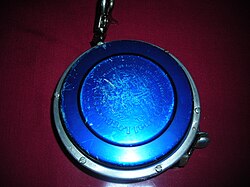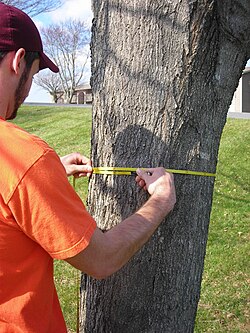Difference between revisions of "AY Honors/Forestry/Answer Key"
(pie replaced by pi) |
|||
| (21 intermediate revisions by the same user not shown) | |||
| Line 1: | Line 1: | ||
| − | {{ | + | {{Expand|date=March 2008}} |
| − | |||
| − | |||
| − | |||
| − | |||
| + | A '''Diameter Tape'''(D-Tape)is a form of [[dendrometer]] that consists of a cloth or metal tape that is mainly used to measure [[diameter at breast height]] (DBH). DBH is measured at a fixed height of 4.5 feet (137.16 cm), where it is easiest for most people to measure [[diameter]]. DBH is measured up high so to avoid measuring a trees' butt swell. Butt swell is where the base of the tree is unconventionally fatter then the rest of the tree. height and diameter are used to determine the volume of a given tree, measuring above the butt swell is required to provide the most accurate measurement.<ref> http://www.cnr.vt.edu/dendro/forsite/dtape.htmAs</ref> | ||
| − | + | [[Image:DTape Picture.JPG|thumb|left|200px|Picture of a Spencer Right Handed Logging Tape]] | |
| − | |||
| − | [[Image: | ||
| − | + | Diameter is easily measured because the tape is calibrated in units of 3.14(pi) inches or centimeters. The tape is actually measuring the trees circumference but since circumference and diameter are related by pi, the diameter can easily be obtained.The only problem with the D-tape is that the measurements assume the tree's trunk cross-sections are perfectly circular.Thus the D-tape just gives an approximation, but this approximation is the easiest and most commonly used dendrometer for DBH.<ref>Moran,L.A, and R.A Williams.2002. Comparison of three dendrometers in measuring diameter at breast height. Northern Journal of Applied Forestry 19:28-33.</ref> | |
| − | |||
| − | |||
| − | |||
| − | == | + | == Measuring Diameter == |
| − | |||
| − | + | To calculate the diameter of a tree, wrap the tape(diameter side facing user) around the tree at 4.5 feet (137.16 cm) above ground. Where the number "0" aligns with the rest of the tape, this is the diameter of the tree. | |
| − | + | [[Image:Using a DTApe.JPG|thumb|left|200px|This shows Brandon measuring the trees DBH at 4.5 feet above ground. He is making sure that the tape is perfectly level and that the tape is not kinked, so as not to mess up the reading of the diameter]] | |
| − | + | [[Image:Measuring dbh.JPG|thumb|center|300px|Thus this tree has a diameter of 16 inches (40.64 cm).]] | |
| − | == | + | |
| − | + | ||
| + | |||
| + | |||
| + | |||
| + | |||
| + | |||
| + | |||
| + | |||
| + | |||
| + | |||
| + | |||
| + | |||
| + | |||
| + | === References === | ||
| + | |||
| + | <references/> | ||
[[Category:Forestry]] | [[Category:Forestry]] | ||
Revision as of 11:32, 13 April 2008
A Diameter Tape(D-Tape)is a form of dendrometer that consists of a cloth or metal tape that is mainly used to measure diameter at breast height (DBH). DBH is measured at a fixed height of 4.5 feet (137.16 cm), where it is easiest for most people to measure diameter. DBH is measured up high so to avoid measuring a trees' butt swell. Butt swell is where the base of the tree is unconventionally fatter then the rest of the tree. height and diameter are used to determine the volume of a given tree, measuring above the butt swell is required to provide the most accurate measurement.&
Diameter is easily measured because the tape is calibrated in units of 3.14(pi) inches or centimeters. The tape is actually measuring the trees circumference but since circumference and diameter are related by pi, the diameter can easily be obtained.The only problem with the D-tape is that the measurements assume the tree's trunk cross-sections are perfectly circular.Thus the D-tape just gives an approximation, but this approximation is the easiest and most commonly used dendrometer for DBH.&
Measuring Diameter
To calculate the diameter of a tree, wrap the tape(diameter side facing user) around the tree at 4.5 feet (137.16 cm) above ground. Where the number "0" aligns with the rest of the tape, this is the diameter of the tree.
References
- ↑ http://www.cnr.vt.edu/dendro/forsite/dtape.htmAs
- ↑ Moran,L.A, and R.A Williams.2002. Comparison of three dendrometers in measuring diameter at breast height. Northern Journal of Applied Forestry 19:28-33.


